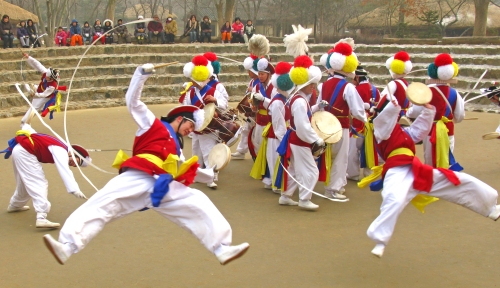
The South Korean pop band Leenalchi consists of four singers, two bassists, and a drummer. Their 2019 album, entitled Sugungga, was based on a pansori piece, and the song Tiger is coming saw significant success after the music video was used to promote South Korean tourism. Leenalchi’s creative interpretation of pansori’s rhythm and harmony attracted over 50 million views for the video and launched their international career. Behind this success, one can also see the historical development of gug’ak (Korean traditional music) and efforts to restore, modernize, popularize, and globalize it. Part of this modernization process has been the fusion of pop music and gug’ak.
After 35 years of Japanese occupation (1910-1945) and the subsequent Korean War (1950-1953), the restoration of tradition became a national priority for many Korean musicians. Under the direction of the Korean government, installed under the Japanese administration, various aspects of Chŏson culture, including the education system and performing arts, suffered a drastic decline–court music was no exception. In this context, Korean traditional music sought restoration, and moreover, an increase in its repertoire through new compositions.
Nationalism played a significant role in the modernization of Korean traditional music. According to Kim Hee-sun, South Korea sought a cultural identity that was uniquely Korean, and traditional music became integral to the narrative of nationalism. Cold War politics further reinforced the role of Korean traditional music as a tool to promote anti-communist ideologies in opposition to the North Korean regime. Through numerous overseas performances during the Cold War, South Korea presented itself as a civilized and cultured nation. Furthermore, Korean traditional music was performed at world events like the Seoul Olympics in 1988 to bolster national pride and identity among South Korean people.

The modernization process also included establishing Korean traditional music departments in higher education. Historically, traditional music was associated with those of lower social status, due to the lower position of musicians in Korean society. However, the establishment of these departments, with government support, elevated the status of Korean traditional music from a low status art form to a respected and even elite profession. For instance, the four singers in Leenalchi are graduates of Seoul National University’s Korean traditional music program, which was established in 1959.
At the end of the Cold War, Korean traditional music adapted to the global market and was used as a tool of national propaganda. The increasing number of young musicians graduating from Korean traditional music programs opened new doors, allowing musicians to explore new forms of Korean traditional music. For example, several projects involved Korean traditional musicians in transnational ensembles, situating Korean traditional music in a global context. In 1993, under the leadership of Park Bum-hoon, a group of musicians from Chung-Ang University joined Orchestra Asia, a group consisting of musicians from Korea, China, and Japan. At the 2009 ASEAN-Korea Summit, musicians from Southeast Asia were invited to perform together with Korean musicians in a large orchestra. More recently, Korean traditional musicians, such as the members of Leenalchi, have taken different approaches to fusing popular music cultures and positioning themselves in a global market.

Developments in Korean traditional music, situated in a new social context beyond the court, enabled musicians to explore their creativity in novel ways. Listening to Leenalchi, free from the constraints of the static “Korean traditional music” label, one hears the breaking of the aural connections between traditional music and national politics–signaling a new era of Korean music as Leenalchi and others venture beyond the realm of tradition.
–Written by Shiho Ogura, RILM intern and MA student in Southeast Asian Studies at the National University of Singapore.
Below is Leenalchi’s well-received video promoting Korean tourism.



